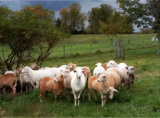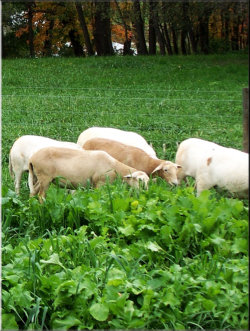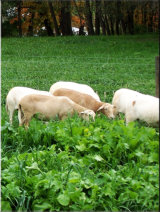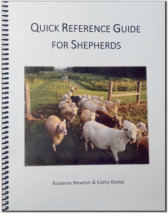
© 2025 Misty Oaks Farm • All Rights Reserved. No portion of this website may be
reproduced without the express written consent of Misty Oaks Farm.
Documented Parasite Resistance
Parasite resistance in Katahdin lambs, and in ewes during lactation (periparturient rise), are correlated and moderately heritable traits. Not all Katahdins are equally resistant. We began using fecal egg counts (FEC) to identify parasite resistant sheep in 2004. Shortly thereafter we joined a select group of Katahdin breeders submitting FEC data to NSIP. This allows us to estimate parasite resistance at weaning and post weaning using genomic data (WFEC and PFEC GEBVs) for more accurate selection. • FECs are done at least twice on all lambs and on all ewes at lambing, the times when sheep are most susceptible to parasites • In order to identify differences in animals there must be a parasite challenge (a group average FEC >500 epg) • Preference is given to ewes with parasite resistance (low FEC) both as a lamb and during lactation • Breeding stock is rigorously selected using both GEBVs and multiple individual FECs • Rams sold for breeding must have individual FEC below the flock average, not require deworming and have FEC GEBVs in the top 20% of the breed
Management of Our Katahdin Flock
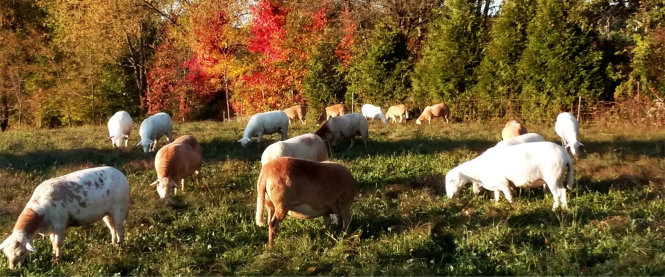
MOF

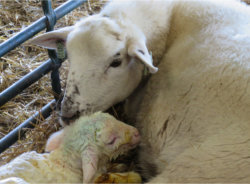
Operating in Ohio, we were first drawn to the Katahdin sheep breed for its outstanding maternal
traits, easy care, hardiness, medium size, natural shedding and ability to excel on grass. We are
committed to maintaining these traits in our flock.
Our Selection Criteria
We’ve participated in the National Sheep Improvement Program (NSIP) since 2004 to obtain estimated breeding values (EBVs) on each animal. Our flock is part of the reference population for the Katahdin breed and we now have Genomically Enhanced EBVs, or GEBVs, on all of our breeding stock. We submit data for growth, number of lambs born and raised, parasite resistance at weaning and postweaning, and mature size. Our selection goals for breeding stock include: • Balanced GEBVs - focus is placed on parasite resistance, growth and prolificacy • Moderately sized ewes - 150 lbs on average for the best ewe efficiency on forage • Early maturity - ewe lambs are bred to lamb at 12 months of age • Outstanding mothering – ewes consistently wean, unassisted, all the lambs they produce • Good growth – 100 lb lambs in 5-6 months on pasture with no deworming • Structurally correct, RR or QR at Codon 171, with an “A” coatForage-Based Production
Our Katahdins work for us. We give them the tools they need (appropriate nutrition and shelter) and expect them to do their job of raising quality twin and triplet lambs unassisted, mostly on grass. Remember, easy care isn’t the same as no care. Optimum production does require management. • Most years sheep are maintained on pasture only from April through December • Ewes are supplemented with corn/soyhulls for about 8 weeks at lambing (mid February – mid April) • Lambs are finished completely on grass most years • BUT, our pastures come first – in drought or other extremes, additional supplementation may be required to prevent overgrazing while maintaining adequate animal performanceStrong Science and Education Focus
We value science-based information as much as personal experience. We have been fortunate to receive several farmer-level Sustainable Agriculture Research and Education (SARE) grants over the years (see below). We have also been involved as farmer-participants in several USDA ARS projects focused on understanding the genetics of parasite resistance. We participated in the first five years of the Virginia Tech forage-based ram test in Glade Springs. We currently participate in the Sheep GEMS project. • Breeding Strategies for Improving Resistance to Gastrointestinal Nematodes in Wool Breeds of Sheep. Group – lead (FNC10-794) • Building on Parasite Resistance Selection in Sheep. Group – lead (FNC07-689) • Selecting Sheep for Parasite Resistance. Group – lead (FNC05-583) • Sustainable Internal Parasite Control for Sheep in a Forage Based System. Individual (FNC04-523) • A summary of our parasite resistance work can be found here.Our Health Program
The health of our flock is very important to us and we maintain strict biosecurity. • Fecal egg counts (FEC) are performed on all lambs at least twice and on all ewes at lambing • FAMACHA is used to selectively deworm animals only if needed • We are free of foot rot and CL (caseous lymphadenitis) • All mature rams and ewes regularly test negative for OPP • All breeding animals test RR or QR at codon 171 for Scrapie resistance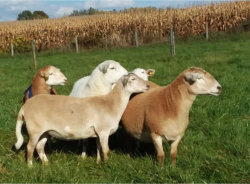
Recommended Links & Resources
• Eastern Alliance for Production Katahdins: https://easternalliancekatahdins.com/ • Katahdin Hair Sheep International (KHSI) https://katahdins.org/ • American Consortium for Small Ruminant Parasite Control: https://www.wormx.info/ • National Sheep Improvement Program (NSIP): http://nsip.org/ • Maryland Small Ruminant Page: https://www.sheepandgoat.com/ • Sustainable Agriculture Research and Education (SARE) program: https://www.sare.org/ • The Grazing Sheep Podcast: https://open.spotify.com/show/2O8Z5v6c7R0c cv5WmYW8Rz • SheepThings: https://sheepthings.com/ • SheepTools: https://info.sheeptools.com/ • Quick Reference Guide for Shepherds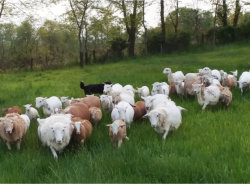
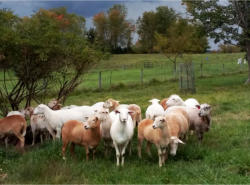




© 2025 Misty Oaks Farm • All Rights Reserved. No
portion of this website may be reproduced without
the express written consent of Misty Oaks Farm.

Management of Our Katahdin
Flock

Documented Parasite Resistance
Parasite resistance in Katahdin lambs, and in ewes during lactation (periparturient rise), are correlated and moderately heritable traits. Not all Katahdins are equally resistant. We began using fecal egg counts (FEC) to identify parasite resistant sheep in 2004. Shortly thereafter we joined a select group of Katahdin breeders submitting FEC data to NSIP. This allows us to estimate parasite resistance at weaning and post weaning using genomic data (WFEC and PFEC GEBVs) for more accurate selection. • FECs are done at least twice on all lambs and on all ewes at lambing, the times when sheep are most susceptible to parasites • In order to identify differences in animals there must be a parasite challenge (a group average FEC >500 epg) • Preference is given to ewes with parasite resistance (low FEC) both as a lamb and during lactation • Breeding stock is rigorously selected using both GEBVs and multiple individual FECs • Rams sold for breeding must have individual FEC below the flock average, not require deworming and have FEC GEBVs in the top 20% of the breed
Operating in Ohio, we were first
drawn to the Katahdin sheep
breed for its outstanding
maternal traits, easy care,
hardiness, medium size, natural shedding and
ability to excel on grass. We are committed to
maintaining these traits in our flock.
Our Selection Criteria
We’ve participated in the National Sheep Improvement Program (NSIP) since 2004 to obtain estimated breeding values (EBVs) on each animal. Our flock is part of the reference population for the Katahdin breed and we now have Genomically Enhanced EBVs, or GEBVs, on all of our breeding stock. We submit data for growth, number of lambs born and raised, parasite resistance at weaning and postweaning, and mature size. Our selection goals for breeding stock include: • Balanced GEBVs - focus is placed on parasite resistance, growth and prolificacy • Moderately sized ewes - 150 lbs on average for the best ewe efficiency on forage • Early maturity - ewe lambs are bred to lamb at 12 months of age • Outstanding mothering – ewes consistently wean, unassisted, all the lambs they produce • Good growth – 100 lb lambs in 5-6 months on pasture with no deworming • Structurally correct, RR or QR at Codon 171, with an “A” coatForage-Based Production
Our Katahdins work for us. We give them the tools they need (appropriate nutrition and shelter) and expect them to do their job of raising quality twin and triplet lambs unassiste d, mostly on grass. Remember, easy care isn’t the same as no care. Optimum production does require management. • Most years sheep are maintained on pasture only from April through December • Ewes are supplemented with corn/soyhulls for about 8 weeks at lambing (mid February – mid April) • Lambs are finished completely on grass most years • BUT, our pastures come first – in drought or other extremes, additional supplementation may be required to prevent overgrazing while maintaining adequate animal performanceStrong Science and Education
Focus
We value science-based information as much as personal experience. We have been fortunate to receive several farmer-level Sustainable Agriculture Research and Education (SARE) grants over the years (see below). We have also been involved as farmer-participants in several USDA ARS projects focused on understanding the genetics of parasite resistance. We participated in the first five years of the Virginia Tech forage-based ram test in Glade Springs. We currently participate in the Sheep GEMS project. • Breeding Strategies for Improving Resistance to Gastrointestinal Nematodes in Wool Breeds of Sheep. Group – lead (FNC10-794) • Building on Parasite Resistance Selection in Sheep. Group – lead (FNC07-689) • Selecting Sheep for Parasite Resistance. Group – lead (FNC05-583) • Sustainable Internal Parasite Control for Sheep in a Forage Based System. Individual (FNC04-523) • A summary of our parasite resistance work can be found here.Recommended Links & Resources
• Eastern Alliance for Production Katahdins: https://easternalliancekatahdins.com/ • Katahdin Hair Sheep International (KHSI) https://katahdins.org/ • American Consortium for Small Ruminant Parasite Control: https://www.wormx.info/ • National Sheep Improvement Program (NSIP): http://nsip.org/ • Maryland Small Ruminant Page: https://www.sheepandgoat.com/ • Sustainable Agriculture Research and Education (SARE) program: https://www.sare.org/ • The Grazing Sheep Podcast: https://open.spotify.com/show/2O8Z5v6 c7R0ccv5WmYW8Rz • SheepThings: https://sheepthings.com/ • SheepTools: https://info.sheeptools.com/ • Quick Reference Guide for Shepherds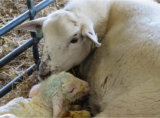
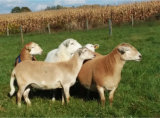
MOF
Our Health Program
The health of our flock is very important to us and we maintain strict biosecurity. • Fecal egg counts (FEC) are performed on all lambs at least twice and on all ewes at lambing • FAMACHA is used to selectively deworm animals only if needed • We are free of foot rot and CL (caseous lymphadenitis) • All mature rams and ewes regularly test negative for OPP • All breeding animals test RR or QR at codon 171 for Scrapie resistance
